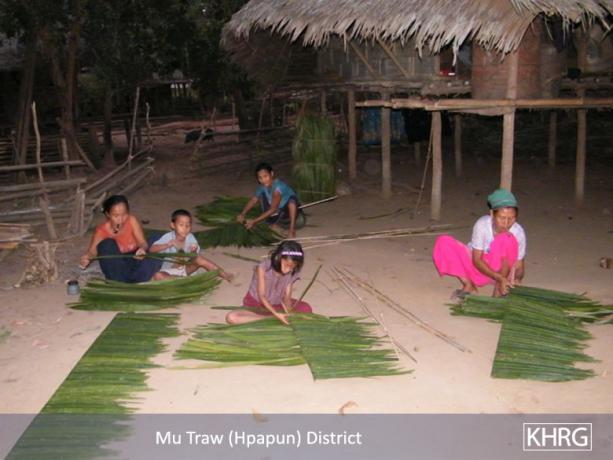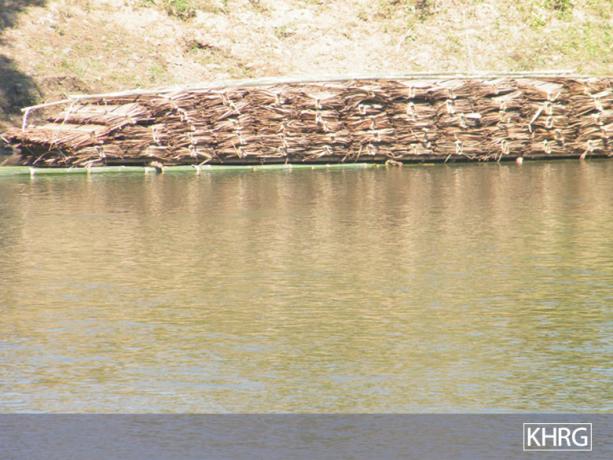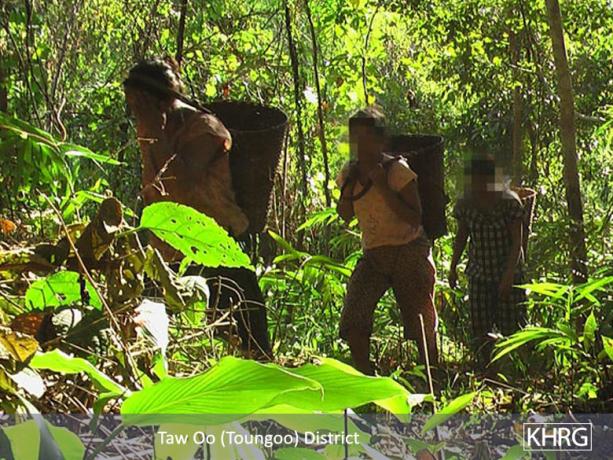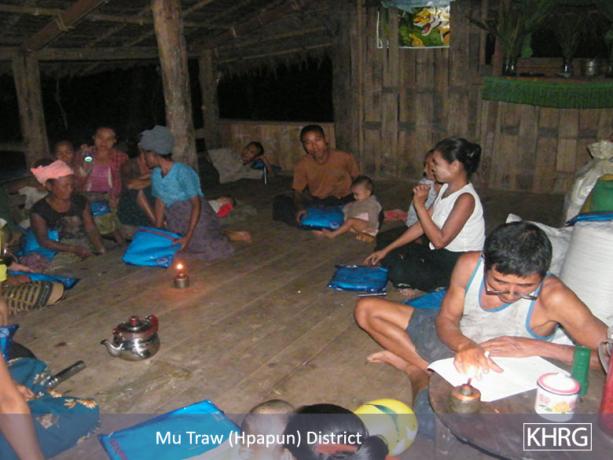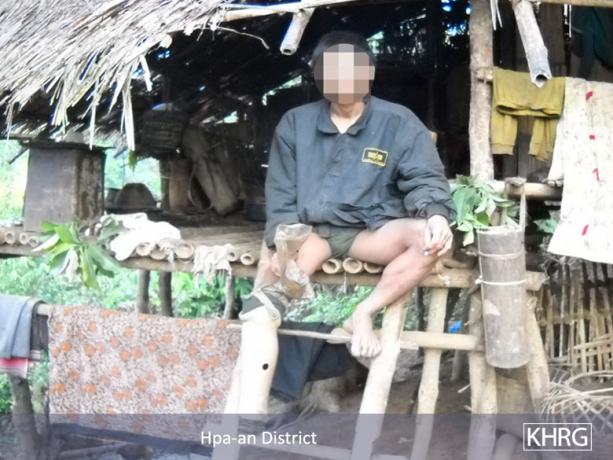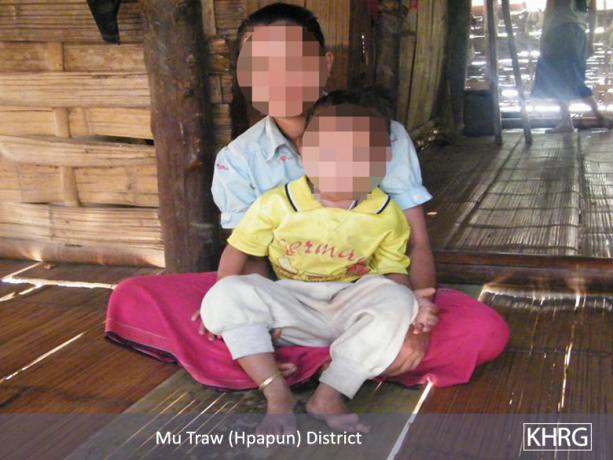The first installment of KHRG's Photo Gallery 2010 presents 131 still images selected from photos taken by field researchers since July 2009. Of these photos, 56 were taken during the latter half of 2009 and 75 were taken during 2010. This edition of the gallery is divided into six subtopics, including Forced relocation and displacement, Life under military control, Convict porters, Children in armed conflict, Soldiers, army camps and weapons, and Land and livelihoods. KHRG is committed to documenting not just the way that villagers are victims of human rights abuses, but also the myriad protection strategies they employ to resist abuse as well as maintain cultural practices and continuity in their lives.
The first installment of KHRG's Photo Gallery 2010 presents 131 still images selected from photos taken by field researchers since July 2009. Of these photos, 56 were taken during the latter half of 2009 and 75 were taken during 2010. This edition of the gallery is divided into six subtopics, including Forced relocation and displacement, Life under military control, Convict porters, Children in armed conflict, Soldiers, army camps and weapons, and Land and livelihoods.
KHRG is committed to documenting not just the way that villagers are victims of human rights abuses, but also the myriad protection strategies they employ to resist abuse as well as maintain cultural practices and continuity in their lives. Consequently, all sections of this report include a wide variety of photo selections, not just photos of villagers as victims.
Since the last photo gallery was released, KHRG has continued to document abuses of the type documented in earlier editions. Villagers already under government control continue to report abuses related to SPDC and DKBA attempts to consolidate control and support ongoing militarization of the countryside. Elsewhere, the SPDC Army continues efforts to expand control, particularly into upland areas in northern Karen State. Though the Northern Karen State Offensive appears to have drawn to a close, attacks on villagers in hiding nonetheless continue. According to the most recent figures, more than 60,000 villagers remain displaced and in hiding. Beginning in May 2009, soldiers from the SPDC and DKBA also became more active in southern Papun District and northern Pa'an districts. In spite of difficulties, however, villagers continue to employ a variety of protection strategies for resisting abuse.
Photos included in the Photo Gallery are identified with alphanumeric characters shown below each image. All photos are by KHRG except where otherwise noted.
Life under military control
The majority of Karen areas in eastern Burma are controlled by the SPDC and DKBA. Villagers in these areas must contend with a variety of abuses related to attempts by these armed groups to consolidate and maintain their control. Abuses in these areas are chiefly exploitative, as both armed groups seek to support militarization of the countryside. In this context, villagers are frequently required to pay high rates of taxation and provide materials and labour for building and maintaining roads and army camps. The KNLA also remains active in areas under SPDC and DKBA control, where it launches attacks and places landmines. In response, villagers accused of supporting the KNLA are detained and questioned, as well as subjected to fines, torture, and the destruction of their property. Landmines and UXOs remain a persistent risk in these areas and villagers are also subjected to restrictions on movement and trade.
These photos, taken on February 24th 2010, show villagers from Mae T--- village, Dweh Loh Township, Papun District, as they prepared to fulfill a demand for porters issued by SPDC soldiers based in Ku Htu Hta army camp. Photo B-1 shows the villagers as they gathered and were counted to make sure that the correct number of porters had been assembled. SPDC commanders often issue orders to village leaders demanding that they provide set numbers of villagers to porter materials or complete other tasks. Photos B-2 and B-3 show the villagers as they embarked from their village towards the Ku Htu Hta army camp. [Photos: KHRG]
These photos, taken on February 7th 2010, show villagers as they fulfilled a demand for forced labour issued by DKBA soldiers in Bu Thoh Township, Papun District. Photos B-4, B-5, and B-6 show the villagers as they worked to make roof thatching demanded by the DKBA soldiers. Note the children participating in the forced labour in photo B-5. Photos B-7 and B-8 show villagers after they finished weaving the thatch and were transporting it to the DKBA camp. [Photos: KHRG] Underscoring that demands for materials function as forced labour, villagers not only have to spend time collecting materials for fabricating goods like thatching, they must also transport the goods, sometimes over long distances. In the case of the villagers pictures above, photo B-9 shows a bamboo raft built by villagers to transport the materials by river, rather than carry them overland. Photo B-10 shows bamboo the DKBA ordered the villagers to cut and transport to the camp. [Photos: KHRG]
Photos B-11 and B-12, taken on January 12th 2010, show some villagers acting as porters carrying supplies for SPDC soldiers from LIB #427, based in G--- village, Tantabin Township, Toungoo District. The men pictured here acting as porters are just three of a much larger group ordered to carry rations for LIB #427. Villages affected by the order included G---, G---, B---, D---, M---, G--- and K---. Porters from these villages had to carry rations from Gkaw Thay Der to the Th'Ay Hta army camp, a trip that took between four and eight hours depending on the weight of the load and the village they departed. For more information on this incident, see "Attacks on cardamom plantations, detention and forced labour in Toungoo District," KHRG, May 2010. [Photos: KHRG]
These photos, taken in March 2010, show villagers from B--- village, Bu Tho Township, as they received mosquito nets from the SPDC in Papun District. Photo B-13 shows a boat belonging to a local villager as it carried the nets into to the village. Photo B-14, shows the B--- village head as he met with villagers to distribute the nets. The village head had to note down the name of each villager receiving a net. Malaria is a significant health threat in eastern Burma, making the mosquito nets a necessity. KHRG's researcher in the area noted, however, that villagers had to provide their names and signatures prior to the constitutional referendum held in May 2008. According to the researcher, villagers were promised mosquito nets if they provided their signatures. Though the researcher did not know more about what these signatures would be used for, he surmised that they might be used to record votes during an election scheduled for later in 2010. [Photos: KHRG]
These photos were taken on August 27th 2009. Photo B-15 shows a truck stopped outside a checkpoint along the Asian Highway at the Special Industrial Zone located in the Thin Gan Nyi Naung area outside Myawaddy Town, on the road from Myawaddy to Kawkareik. Photo in B-16, shows officials operating the checkpoint, including another checkpoint near Thin Gan Nyi Naung. This checkpoint is manned by SPDC soldiers, immigration officials, Na Sa Ka and soldiers from the DKBA and KPF. The Asian Highway is one of the major routes linking overland trade between Thailand and Burma. It is also home to an extensive network of checkpoints and tollgates, which must be paid by travelers and traders if they wish to pass. More information on the Asian Highway can be found in "Tollgates upon tollgates: En route with extortion along the Asian Highway," KHRG, October 2009. [Photos: KHRG]
Photo B-17 taken in the beginning of 2010, shows a former DKBA soldier from Brigade #555 named Pa D---, age 39, from M--- village, Lu Pleh Township, Pa'an District. On the first of June, he was sent to attack KNLA 7th Brigade. During the attack he stepped on a landmine and lost the lower half of his left leg. According to P---, he was not cared for by the DKBA after receiving the injury. [photo: KHRG] Photo B-18 taken in the beginning of 2010, shows Pa L---, age 45, from M--- village, Lu Pleh Township, Pa'an District. Pa L--- was arrested by DKBA Brigade #555 and forced to act as a porter carrying RPGs. Pa L--- told KHRG he didn't have enough food or sleep while working for the DKBA from the beginning of June until July 10th 2009. On July 10th 2009 at approximately 7 in the morning, Pa L--- was ordered to find firewood and cook for the DKBA soldiers. While searching for firewood, he stepped on a landmine in the Kloh Yaw Lay valley. After the incident, DKBA soldiers told other villagers to carry him to his home village, without providing him any medical help or support. Pa L--- was able to obtain a prosthetic leg, shown at the bottom left, and now works to cultivate his field as best he can. [photo: KHRG]
Photo B-19 taken on March 13th 2009, shows men from Sh--- village, Tantabin Township, as they return from collecting firewood and roofing materials. Travelling without permission from the Burma Army, they were wary of encountering soldiers. Four days earlier, SPDC soldiers near Th--- village had seized a group of villagers also transporting thatch by ox cart. The villagers and oxen were held at the Y--- army camp until the Th--- village head could arrange payment of 150,000 kyat (approx. US $141.51) to secure their release. More information about this incident can be found in the report, "Patrols, movement restrictions and forced labour in Toungoo District," KHRG, September 2009. [Photo: KHRG]
These photos were taken on August 27th 2009. Photos B-20 and B-21, taken in May 2009, show 22-year-old Saw C---, from Taw L---, Nyaunglebin District, dead after setting off an unexploded mortar shell. Burma Army soldiers from IB #60 had fired the mortar shell on September 15th 2008 while fighting with the KNLA. At the time, the mortar shell failed to explode and remained in the ground until April 25th 2009, when S--- attempted to remove it, triggering the fuse and setting off the explosion which killed him. More information about this incident can be found in "Livelihood consequences of SPDC restrictions and patrols in Nyaunglebin District," KHRG, September 2009. [Photos: KHRG]
On December 18th 2009, soldiers from LIB #217 and 709 shot and killed Pa K---, age 25, outside his home in K--- village, Bu Tho Township, Papun District. According to the village head of K--- village, shown standing behind Pa K---‘s grave in photo B-22 Pa K--- was shot as he returned to his village from a hunting trip. Accompanying Pa K--- on the trip was Pa B---, age 13, who ran to K--- village after escaping unharmed. When the K--- village head then asked SPDC soldiers why they had killed his villager, the soldiers replied that they hadn’t shot a villager, but they had been hunting and didn’t know where all the shots they fired had gone. Pa K--- is survived by his wife and 3-year-old son, pictured in photo B-23. [Photos: KHRG]








